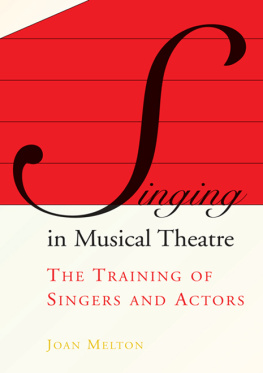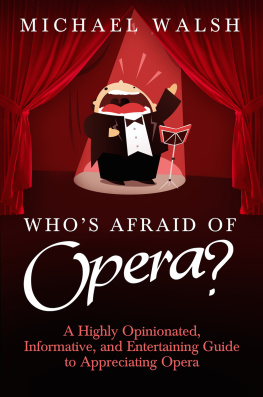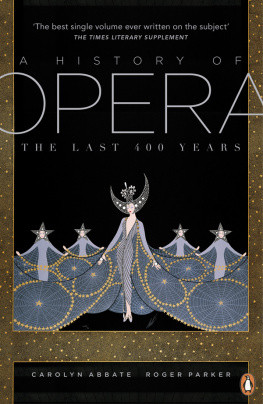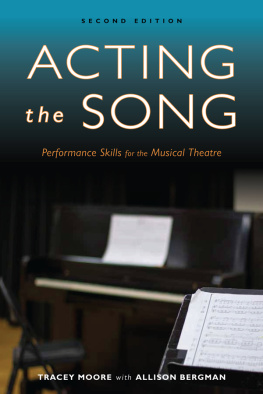Cover

| title | : | Singing, Acting, and Movement in Opera : A Guide to Singer-getics |
| author | : | Clark, Mark Ross.; Clark, Lynn V. |
| publisher | : | Indiana University Press |
| isbn10 | asin | : | 0253341132 |
| print isbn13 | : | 9780253341136 |
| ebook isbn13 | : | 9780253109392 |
| language | : | English |
| subject | Acting in opera, Singing--Interpretation (Phrasing, dynamics, etc.) |
| publication date | : | 2002 |
| lcc | : | MT956.C65 2002eb |
| ddc | : | 792.5/028 |
| subject | : | Acting in opera, Singing--Interpretation (Phrasing, dynamics, etc.) |
Page i
SINGING, ACTING, AND MOVEMENT IN Opera
Page ii
MARK ROSS CLARK
LYNN V. CLARK, Curriculum Designer

Page iii
SINGING, ACTING, AND MOVEMENT IN Opera
A Guide to Singer-getics
Page iv
This book is a publication of
Indiana University Press
601 North Morton Street
Bloomington, IN 47404-3797 USA
http://iupress.indiana.edu
Telephone orders 800-842-6796
Fax orders 812-855-7931
E-mail orders iuporder@indiana.edu
2002 by Mark Ross Clark
''Postural Alignment" by Emily Bogard 2002
by Indiana University Press
All rights reserved
No part of this book may be reproduced or utilized in any form or by any means, electronic or mechanical, including photocopying and recording, or by any information storage and retrieval system, without permission in writing from the publisher. The Association of American University Presses' Resolution on Permissions constitutes the only exception to this prohibition.
The paper used in this publication meets the minimum requirements of American National Standard for Information SciencesPermanence of Paper for Printed Library Materials, ANSI Z39.48-1984.
Manufactured in the United States of America
Library of Congress Cataloging-in-Publication Data
Clark, Mark Ross, date
Singing, acting, and movement in opera : a guide to singer
getics / by Mark Ross Clark ; Lynn V. Clark, curriculum
designer.
p. cm.
Includes bibliographical references (p. ) and index.
ISBN 0-253-34113-2 (cloth : alk. paper) ISBN 0-253-21532-3
(pbk. : alk. paper)
1. Acting in opera. 2. SingingInterpretation (Phrasing,
dynamics, etc.) I. Clark, Lynn V. II. Title.
MT956 .C65 2002
792.5'028dc21
2002000416
1 2 3 4 5 07 06 05 04 03 02
Page v
CONTENTS
Foreword: A Message from Tito Capobianco | vii |
List of Interviews | ix |
Using the Guide | xi |
PART I. PREPARATION |
1. Body Awareness: Stretching for Flexibility and Power | |
2. Postural: Aligning the Body | |
3. The Expressive Face: Communicating Emotions Onstage | |
4. Character Study: Decoding the Clues to Character | |
5. Environment: Setting the Stage | |
PART II. INTEGRATION |
6. Elements of Stagecraft: Learning the Language | |
7. Historical Etiquette: Bowing to Tradition | |
8. Improvisation: Unlocking the Imagination | |
9. Monologues: Talking Opera | |
10. Physical Analysis: Moving in Character | |
PART III. APPLICATION |
11. The Aria: Making Choices | |
12. The Scene: Putting It All Together | |
13. The Opera: Preparing a Role | |
14. Performance Anxiety: Facing Fear | |
15. Careers in Opera: Stepping Out | |
Appendix A. Attitude Chart | 117 |
Appendix B. Postural Alignment by Emily Bogard | 118 |
Appendix C. Literary and Historical Background of Selected Operas | 130 |
Appendix D. Stage Manager's Handbook | 139 |
Appendix E. Stage Combat: Faints, Falls, and Fights | 145 |
Bibliography | 149 |
Index | 151 |
Page vi
This page intentionally left blank.
Page vii
Foreword:
A Message from Tito Capobianco
The great works of art that endure and last forever are those that never cease to produce new meanings within their interpreters, performers, readers, viewers, listeners, and audiences. To reach this state of validity in opera, an art form comprised of a ''sublime ambiguity of the greatest artistic disciplines, all led by the human voice," we must provide its future artists and teachers every available tool to make possible, without limitations, new ways of expression and interpretation in our time of constant change and evolution.
The present book is a remarkable collection of observations and reflections on past experiences by many excellent artists and teachers that will doubtless help the new generation of those interested in creating "opera magic." They will find new answers to questions of emotional searching, motivation, responses to past failures, and ways of discovering, reevaluating, and affirming past values. The inclusion of many exercises encourages experimentation in finding the individuality and singularity of each artist, proving that time and again, with the discipline of the proper talent and perseverance, everything onstage can be possible.
This book clearly avoids the intellectual contradiction that denies the spontaneous and passionate "projection of emotion" that rules opera, offering innumerable avenues and a variety of ways to achieve creativity and conviction of expression.
In our contemporary state of "mega-multiculturalism," socioeconomic globalization, and technological revolution, it is extremely necessary in all of the arts, and most especially in opera, that we reconsider every aspect involved to ensure a sensitive and true participation in our own cultural future. If we want to expand the boundaries of people's perceptions, the following pages are a serious attempt to achieve just that.
Tito Capobianco
February 2001
Page viii
This page intentionally left blank.
Page ix
List of Interviews
I would like to thank the following artists and experts for sharing their time and talents during interviews. Their words and wisdom have been invaluable to this book.
Next page









